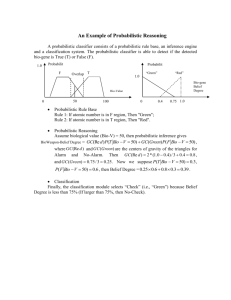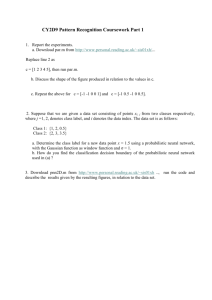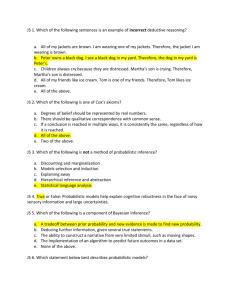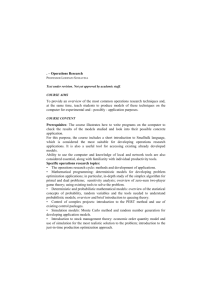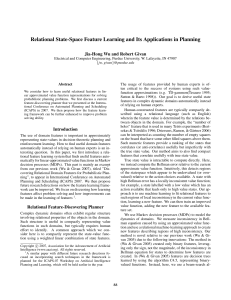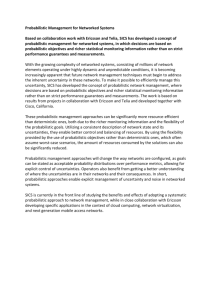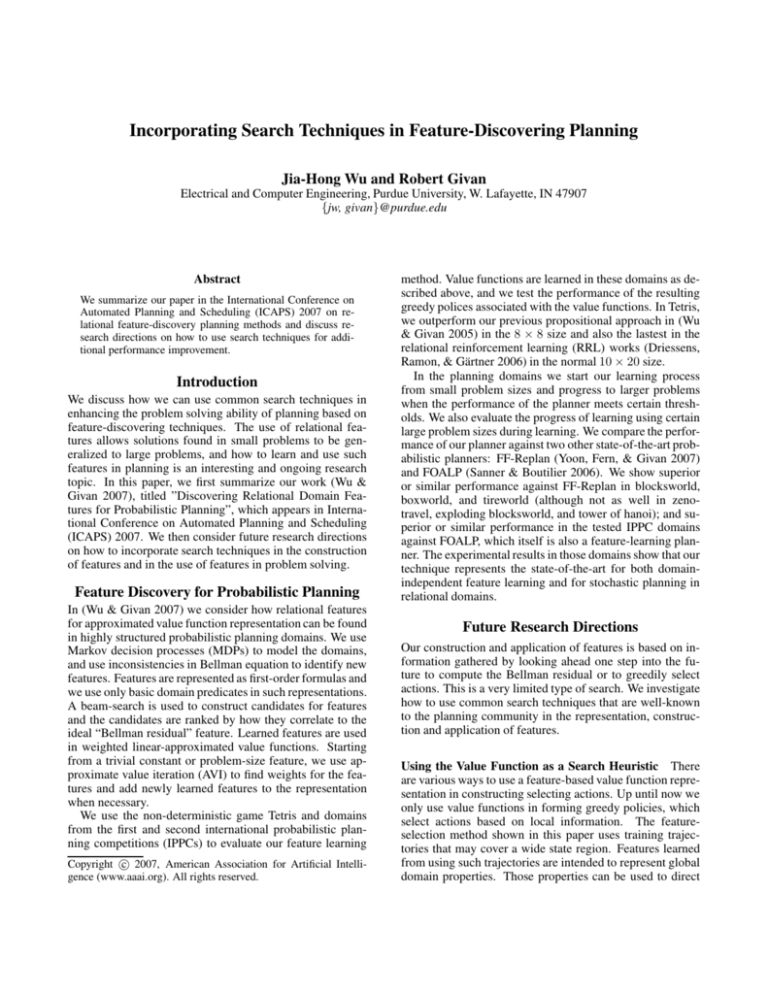
Incorporating Search Techniques in Feature-Discovering Planning
Jia-Hong Wu and Robert Givan
Electrical and Computer Engineering, Purdue University, W. Lafayette, IN 47907
{jw, givan}@purdue.edu
Abstract
We summarize our paper in the International Conference on
Automated Planning and Scheduling (ICAPS) 2007 on relational feature-discovery planning methods and discuss research directions on how to use search techniques for additional performance improvement.
Introduction
We discuss how we can use common search techniques in
enhancing the problem solving ability of planning based on
feature-discovering techniques. The use of relational features allows solutions found in small problems to be generalized to large problems, and how to learn and use such
features in planning is an interesting and ongoing research
topic. In this paper, we first summarize our work (Wu &
Givan 2007), titled ”Discovering Relational Domain Features for Probabilistic Planning”, which appears in International Conference on Automated Planning and Scheduling
(ICAPS) 2007. We then consider future research directions
on how to incorporate search techniques in the construction
of features and in the use of features in problem solving.
Feature Discovery for Probabilistic Planning
In (Wu & Givan 2007) we consider how relational features
for approximated value function representation can be found
in highly structured probabilistic planning domains. We use
Markov decision processes (MDPs) to model the domains,
and use inconsistencies in Bellman equation to identify new
features. Features are represented as first-order formulas and
we use only basic domain predicates in such representations.
A beam-search is used to construct candidates for features
and the candidates are ranked by how they correlate to the
ideal “Bellman residual” feature. Learned features are used
in weighted linear-approximated value functions. Starting
from a trivial constant or problem-size feature, we use approximate value iteration (AVI) to find weights for the features and add newly learned features to the representation
when necessary.
We use the non-deterministic game Tetris and domains
from the first and second international probabilistic planning competitions (IPPCs) to evaluate our feature learning
c 2007, American Association for Artificial IntelliCopyright gence (www.aaai.org). All rights reserved.
method. Value functions are learned in these domains as described above, and we test the performance of the resulting
greedy polices associated with the value functions. In Tetris,
we outperform our previous propositional approach in (Wu
& Givan 2005) in the 8 × 8 size and also the lastest in the
relational reinforcement learning (RRL) works (Driessens,
Ramon, & Gärtner 2006) in the normal 10 × 20 size.
In the planning domains we start our learning process
from small problem sizes and progress to larger problems
when the performance of the planner meets certain thresholds. We also evaluate the progress of learning using certain
large problem sizes during learning. We compare the performance of our planner against two other state-of-the-art probabilistic planners: FF-Replan (Yoon, Fern, & Givan 2007)
and FOALP (Sanner & Boutilier 2006). We show superior
or similar performance against FF-Replan in blocksworld,
boxworld, and tireworld (although not as well in zenotravel, exploding blocksworld, and tower of hanoi); and superior or similar performance in the tested IPPC domains
against FOALP, which itself is also a feature-learning planner. The experimental results in those domains show that our
technique represents the state-of-the-art for both domainindependent feature learning and for stochastic planning in
relational domains.
Future Research Directions
Our construction and application of features is based on information gathered by looking ahead one step into the future to compute the Bellman residual or to greedily select
actions. This is a very limited type of search. We investigate
how to use common search techniques that are well-known
to the planning community in the representation, construction and application of features.
Using the Value Function as a Search Heuristic There
are various ways to use a feature-based value function representation in constructing selecting actions. Up until now we
only use value functions in forming greedy policies, which
select actions based on local information. The featureselection method shown in this paper uses training trajectories that may cover a wide state region. Features learned
from using such trajectories are intended to represent global
domain properties. Those properties can be used to direct
a general solution “flow” but may not provide local details
on how to best act. On the other hand, search techniques
can focus on the local details, but can be very expensive if
the space required to search is large and no guidance (e.g.,
heuristic) is provided. Here, we consider how these two approaches can be combined to improve problem solving in
planning.
We consider combining various search techniques with
our feature-discovering method to be a novel research direction. Little previous research has centered around featurediscovering value-function construction, and we know of
no previous work that uses such automatically constructed
value function as a search heuristic. Search heuristics are
usually directly designed by humans, or calculated by following domain-independent rules formulated for this purpose by humans. Some previous techniques (Hoffmann
& Nebel 2001; Prieditis 1993) transform given problems
to new ones that are generally in reduced form, and automatically finds search heuristics by considering solutions or
state structures to such transformed problems. Our featurediscovering method does not consider transformed problems
and only works directly on the original planning problems.
The implementation and evaluation of the novel combination of our feature-discovery methods with known search
methods may lead to the discovery of more effective planners.
We discuss several possible approaches to use value functions found by our feature-discovering method as search
heuristics. A greedy policy can be regarded as always looking ahead one step at possible outcomes for each action
choice and picking the action that leads to the best expected
outcomes. A simple extension to greedy policies is to search
more than one step ahead but still to a predetermined horizon. The most effective search horizon may differ from domain to domain or even among the states in a problem. A
large horizon makes it easier to escape local optima but can
be slow to compute. A small horizon has the reverse effect.
A more sophisticated approach is to determine when to terminate a search process by checking the heuristic value. For
example, the enforced hill-climbing method used in the deterministic planner FF (Hoffmann & Nebel 2001) repeatedly
finds and progresses to states with better heuristic value than
the current state, terminating when the goal is reached or no
state with better value is found (failed). We can also choose
to perform a complete informed search, such as using bestfirst search (Russell & Norvig 1995).
In probabilistic environments the computation cost for
searches is even more sensitive to the growth of search depth
due to the need to combine results for different probabilistic
outcomes. This combination is usually done by computing
the expected value of each action from every possible outcome. This means we need to search into all non-trivial outcomes even though we may have already found a solution
path through some outcome. This is not always necessary in
practice though, as we can choose to ignore the probabilistic information and instead create action aliases for every
non-trivial outcome for each actions. The probabilistic planning problems can thus be approximated by deterministic
ones, avoiding the need to compute expected values. In-
deed, the latest version of FF-Replan (Yoon, Fern, & Givan
2007), which is one of the state-of-the-art probabilistic planners, uses this approach and outperforms all competitors in
some probabilistic domains in the fifth International Planning Competition. FF-Replan uses FF (Hoffmann & Nebel
2001) to solve the determinized plan, and replans if the actual outcome deviates from the predicted one. In our case,
we can consider heuristic search in the determinized problem as an approximation to the more expensive direct expectimax search.
What may also need to be addressed when using value
functions as search heuristics is how efficient the value functions can be computed. To be used as a search heuristic,
a value function should be as computationally efficient as
possible; for feature-based value functions, this implies that
the features should be evaluated as fast as possible. When
designing the feature language for a search heuristic, the
representation of the feature must be simpler than the one
used in our feature learning system. Those features do not
need to perform well when being used in a value function
for greedy policies, but should still represent some general
dynamic structure in the domain so that an informed search
can be as efficient as possible. For example, we can modify
our feature learner so that ease of computation is part of the
scoring of candidate features, a form of regularization.
Searching for True State Value in Feature Learning In
our feature learning method, candidates that are best correlated to Bellman residual are selected. Bellman residual is
essentially decided by finding value inconsistencies between
neighboring states. Although we have shown that using this
measure is useful in finding features to approximate state
value, ideally we would like to use the difference between
true value and evaluated value in states as a measure. We
may attempt to find a better approximation to such difference than using Bellman residual by searching deep into the
state space. Informed search can be used here to increase the
efficiency.
Incorporating Searches in Feature Structure Some regular structure in a planning problem may not be properly
represented using features describing individual states. For
example, in logistics or boxworld, we may want to learn a
concept that a truck carrying a certain package can move
correctly toward the destination of the package by passing
a certain city. This concept is hard to describe if a single
state is observed unless the truck is already close to the destination. But if search is allowed while evaluating whether
a concept is true in a state, we can find out if the truck is
driving on a shortest path to the goal by searching from the
current state and evaluate that if there is another shorter path
to the destination. To speed up this search process, we only
need to expand the states that involve changes in objects that
we are concerned about.
References
Driessens, K.; Ramon, J.; and Gärtner, T. 2006. Graph
kernels and gaussian processes for relational reinforcement
learning. MLJ 64:91–119.
Hoffmann, J., and Nebel, B. 2001. The FF planning system: Fast plan generation through heuristic search. JAIR
14:253–302.
Prieditis, A. 1993. Machine discovery of effective admissible heuristics. Machine Learning 12:117–141.
Russell, S., and Norvig, P. 1995. Artificial Intelligence: A
Modern Approach. Prentice-Hall, New Jersey.
Sanner, S., and Boutilier, C. 2006. Practical linear valueapproximation techniques for first-order mdps. In UAI.
Wu, J., and Givan, R. 2005. Feature-discovering approximate value iteration methods. In Abstraction, Reformulation and Approximation : 6th International Symposium.
Wu, J., and Givan, R. 2007. Discovering relational domain
features for probabilistic planning. In ICAPS. To Appear.
Yoon, S.; Fern, A.; and Givan, R. 2007. FF-Replan: A
baseline for probabilistic planning. In ICAPS. To Appear.




